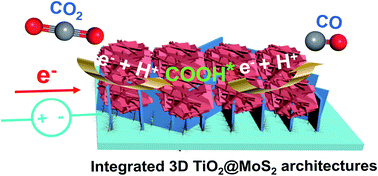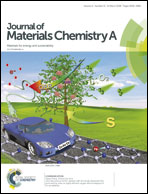Robust and selective electrochemical reduction of CO2: the case of integrated 3D TiO2@MoS2 architectures and Ti–S bonding effects†
Abstract
Developing efficient and affordable catalysts toward electrochemical reduction of CO2 to valuable chemicals is of great significance for energy and environmental sustainability, which can be efficaciously achieved by catalyst structure steering. In this study, we propose an ingenious strategy to modulate MoS2 favorable for CO2 reduction by fabricating an integrated three-dimensional (3D) TiO2@MoS2 architecture containing Ti–S bonds, the formation of which, revealed by density functional theory calculations, has changed the electric properties of the MoS2 layer and the adsorption characters of Mo exposed edges. The modulated MoS2 is vigorous for CO2 reduction due to the decrease of both the binding energy of CO2 and the energy barriers of CO2 reduction reaction pathways. Experimentally, the integrated 3D TiO2@MoS2 architectures can act as efficient and stable catalysts for selective reduction of CO2 to CO. The optimized composite showed a negligible onset overpotential of 100 mV for CO formation in KHCO3 solution, and a maximum faradaic efficiency of ∼82% for CO at −0.7 V vs. RHE with a large partial current density for CO of 68 mA cm−2. Additionally, the integrated 3D electrodes exhibited superior stability during CO2 reduction. This study will shed light on the modification of electrocatalysts for efficient CO2 reduction through structure steering.



 Please wait while we load your content...
Please wait while we load your content...